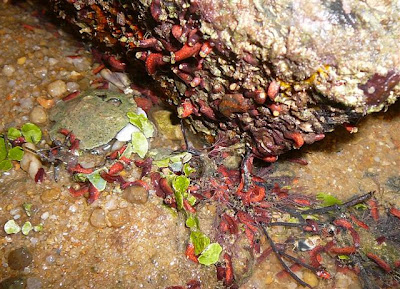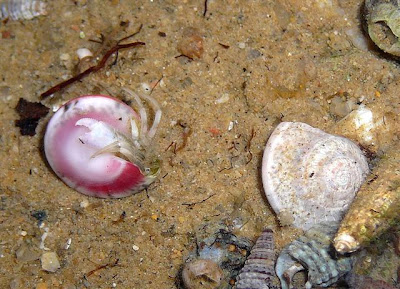After an exploration of a new shore during a not-so-low tide, this time a small team of us managed to come back during an extreme low tide. It wasn't easy getting to the shore but we were glad we eventually did because there were many WOW surprises waiting for us.
This shore is VERY soft as Andy once sank knee deep the last time he came. That happened to me too! However, the super low tide revealed a section of hard sand that we could stepped on and off we go to the low water level mark to explore for the first time! The area was quite extensive. Wow.
On the sandflat facing the sea are many adult Haddon's carpet anemones (Stichodactyla haddoni) including this anemone in a pretty purple colour, like the ones you can find in Chek Jawa.
There are carpet anemones in other shades of green too and this one even a pair of anemone shrimps living on it.
These Commensal shrimps are probably Periclimenes sp. and they listed as 'Vulnerable' on the Red List of threatened animals of Singapore due to collection for the aquarium trade.
Other anemones spotted include several of these plain sea anemones.
And this sea anemone that I've no idea of it's identification.
There are also many peacock anemones (Order Ceriantharia) in different colours. We also found an orange peacock anemone with phoronid worms.
As seen from my previous trip during a not so low tide, finally I got to see the clumps of tape seagrasses (Enhalus acoroides) with many snails and sea cucumbers on it.
There was also a patch of spoon seagrass (Halophila ovalis) and needle seagrass (Halodule sp.) nearby with plenty of living snails.
The snails include the intricate looking Dubious nerites (Clithon oualaniensis) and creeper snails.
There are also plenty of sea cucumbers on the seagrass area including this orange sea cucumber that is still awaiting for identification.
There are also many thorny sea cucumbers (Colochirus quadrangularis) all over the sandflat and seagrass patches. You can see its filter feeding tentacles out to filter feed plankton and suspended organic particles from the water especially during high tide.
We could also find the not so common warty sea cucumber (Cercodemas anceps). Wow, there's quite a good variety of sea cucumbers already.
Furthermore, we got to find this weird white sea cucumber that we don't know what it is! Wow.
Mei Lin found this ball sea cucumber (Phyllophorus sp.) buried in the sand and she sighted it by it's feeding tentacles above the sand.
And the most WOW discovery of the sea cucumbers there will be the many tiny red sea cucumbers that were common on Chek Jawa and Tuas, in groups of many individuals.
They are about 1cm or shorter. Often mistaken for worms, each has all the features that bigger sea cucumbers have. Tiny long white tube feet emerge along the body length, and are used to cling to the surface.
You can also see from this photograph that their long branched feeding tentacles emerge from the mouth.
I've not seen this sea cucumber before so it's really a wow discovery for me, in addition to its many numbers.
As for sea stars, I found this large painted sand star (Astropecten sp.) on top of the four rare eight-armed sea stars that I've described in a separate post. I also found a tiny biscuit sea star on the sand flat.
How about sand dollars? It is delighting to find many rare Laganum sand dollars (Laganum depressum) that I've never seen before. WOW! They were only reported intertidally before by Ria previously at the Sentosa North shore that has already been buried for IR reclamation.
There are also many of the usual Cake sand dollars at the bottom left of the photograph (Arachnoides placenta).
They come in different shades of pink and they prefer soft and silty sand substrate to live in.
This rare sand dollar has somewhat pentagonal rather than circular shape. On the upperside it is thick at the edges and at the centre, and thinner elsewhere, creating a shallow circular depression around the centre. Spines at the edges of the body are longer.
The underside where the anus can be found, has long spines.
What a wonderful find of rare sand dollars in large numbers at this shore!
On the sand flat is also this juvenile sole fish (Family Cynoglossidae) that swam at the sandy bottom.
There was also this bloody red worm that I've no idea what it is. But it did look like it bleed.
Scurrying on the shore and running away quickly are many of the ghost crabs (Ocypode cerathophthalmus). This particular one did not run away from me because it seems to be feeding on another small crab! Wow.
Soft sandy and silty shore seems to also harbour many molluscs and we found a number of surprising finds at this shore.
Including this live gong gong snail (Strombus canarium) with both eye stalks peering out at me.
There are also snails spotted that are alive instead of the usual dead shells we sighted usually at other shores. This one is possibly a Bufonaria sp. (Family Bursidae).
This is yet another snail with beautiful shell that is ALIVE!
At the high shore, I was wow-ed by the aggregation of snails. There were plenty of space but I don't know why they aggregated like that!
Could they be all dead snails that are inhabitated by hermit crabs? I regret not checking it out more.
The only thing I checked was the button shell that is actually inhabited by a hermit crab.
If the above aggregation were all hermit crabs, then they might be doing a MASSIVE exchange of shells. Wow. With the christmas spirit somemore. Hahaha.
Other than the numerous tiger moon snails (Natica tigrina) encountered, there are also pretty lined moon snails (Natica lineata).
The final WOW of the day must be this snail.
I saw this snail that we all have never seen before! It has a very pretty mantle covering its intricate shell. In addition, it also has a pinkish siphon.
The underside of this snail reveal a orange foot that is oval in shape.
Don't underestimate it's foot because it seems to be rather strong! I heard the ladies said it was doing pushups on the sand. :P
We found several others of this special snail soon after the first sighting.
Great find of this newly sighted snail! Hopefully we can get its identification soon to see if it's a new record in Singapore.
There's so much to explore in our shores of Singapore. Unexplored and hidden shores might have rare and new stuffs that no one can ever imagine. Before they are gone, by coastal development, we really need to take a closer look at the biodiversity of the marine life and know what exactly we have on our waters.
Monday, December 15, 2008
The WOW shore exploration
Subscribe to:
Post Comments (Atom)






































No comments:
Post a Comment